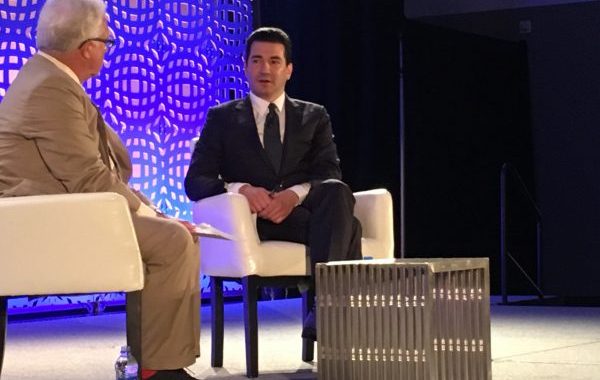For the record, Bernie Sanders looks like I look when my mom is arguing with my sister in the car and I’m just looking at the road. (Photo by Drew Angerer/Getty Images)
During last night’s Democratic debate, Senator Kamala Harris beat former Vice President Joe Biden about the face and neck over his views on segregation and busing. Back in the 1970s, “busing” was one way to integrate schools that Joe Biden, generally speaking, opposed in part and supported in part. During the debate, Biden literally asked to be saved by the bell, saying to no one in particular that “my time is up.” But after the debate, in the spin room, Biden tried to make a fine distinction between de jure segregation, which Biden opposed, and de facto segregation. Biden didn’t specifically say he supported de facto segregation, but he seemed to be suggesting that the remedy for that was not a power of the federal government. Or something.
At a surface level, this can sound like a debate about the past, and that’s certainly how Biden and white men of a certain age who agreed with Biden back in the day want you to think of it. But this debate is very much about the present, and what Biden will do, or Harris will do, to stop the very real segregation that we still experience today.
First we must define our terms, and lawyers know that the first term to understand here is “with all deliberate speed.” That’s the language from Brown v. Board of Education II. The original Brown decision ordered desegregation, but it didn’t say how or, most importantly, when. Brown II came out with some of the details and included the line that schools should be integrated with all deliberate speed.
Well, if you give segregationists a soft deadline, they’ll find a way to never get around to it. Fast forward to the 1970s and, guess what, many schools were not integrated.
The 70s-era fight for desegregation centered around “busing.” After Brown, segregationists — from the North, South, East, and West, mind you — pretty quickly figured out that you didn’t really have to integrate schools if you had one school close to where all the white people lived in your town, and another school close to where all the black people lived in your town. Busing was the process where black kids from “the wrong side of the tracks” would be put into white schools, and occasionally (though more rarely) white kids from “the good part of town” would be sent to schools in black areas.
As you can imagine, some white people — some of whom I’m sure didn’t have “a racist bone in their body” — had a serious problem with this. And so we had more Supreme Court cases. The most famous of these is probably Swann v. Charlotte-Mecklenburg Board of Education, decided in 1971. There, a unanimous Court ruled that federal courts could impose “equitable remedies” upon school districts which violated orders to desegregate. Essentially, Swann allowed busing to be a thing.
But, racism never takes a defeat lying down. For white people, the obvious solution to desegregation and busing was what we now call “white flight.” White people abandoned “urban” areas and fled to the surrounding suburban counties, where they could have their whites-only schools without meddling from the government.
That led to another Supreme Court busing case, Milliken v. Bradley. There, Detroit wanted the right to bus children — kindergartners, actually — to surrounding districts, in the name of desegregation. That proved to be a bridge too far for the Burger Court. The Court ruled 5-4, over a dissent from Justice Thurgoood Marshall, that white suburban schools could not be forced to desegregate unless it could be shown that the district lines were drawn, on purpose, with the goal of segregation. The decision also emphasized the importance of “local control” over these kinds of state decisions, since technically the NAACP was suing Michigan Governor William Milliken to force him to desegregate schools in suburban Detroit.
And… that explains Detroit, actually. Know that every time you crap on Detroit, what you are doing is victim-blaming black people because white “working class” folks with good jobs at General Motors FLED DETROIT so that their kids wouldn’t have to go to school with black kids, and the Supreme Court said that was cool.
In any event, Milliken is how we get to the important legal distinction between de jure and de facto segregation. De jure segregation is segregation imposed by the law. De facto segregation is the kind of segregation that, ALLEGEDLY, occurs just by happenstance. You know, like white people are just walking around, minding their own business, and whoops, they trip on some racial segregation in schools. “Oh noes,” one imagines these white people saying. “I haz whites-only schoolz now? Whoopsie!” By the 1970s, it was easy for people to come out against de jure segregation; the battle line was over de facto segregation, because the Supreme Court had made de facto segregation a thing that states were allowed to do under the rubric of “local control,” which was a less rebellious way of talking about “state’s rights.”
Enter Joe Biden. Biden was first elected to the U.S. Senate in 1972, when I was minus-six according to the anti-choice lobby. He was right in the middle of the busing debate. And his record on busing is not great. From Mother Jones:
During one debate on the Senate floor, Biden said, “I have become convinced that busing is a bankrupt concept,” as he backed an anti-busing measure sponsored by avowed segregationist Sen. Jesse Helms. When a federally mandated integration program was set to begin in Biden’s home state in the late 1970s, the Delaware senator co-sponsored an amendment, tacked on to an education appropriations bill, which would have limited courts’ ability to order busing and imposed a halt on all pending busing orders around the country. The Washington Post at the time called it “the most far-reaching antibusing measure to receive serious consideration in the Senate.” (It failed by a slim margin.)
What Kamala Harris was asking Joe Biden to do during the debate was explain, apologize for, or disavow his own actual position here.
Instead, Biden defended it. From The Hill:
“I supported busing to eliminate de jure segregation,” he told MSNBC after the debate. “But what we’re talking about is whether or not the Department of Education, as opposed to the courts, could order de jure segregation, meaning segregation imposed by law.”
Yes, we know that Biden doesn’t believe in legally mandated segregation. The question is whether he still believes in allowing schools to functionally segregate without interference from the federal government. Does he agree with the majority opinion in Milliken, or does he agree with Thurgood Marshall’s dissent? That is the question.
Like I said, the Biden people want you to think that this is a conversation about the past, but it’s actually a conversation about now, because de facto segregation is exactly the school segregation we have left. And, as most blacks and Latinos already know, it’s the “liberal” states, the ones Democrats control, where black and brown students face some of the most intense segregation. From the New York Times:
White students now account for less than half of the nation’s public school students, and Latinos are the most deeply segregated racial group in schools, according to the researchers.
While segregation was once most severe in the former states of the Confederacy, in 2016 it was in four liberal states — New York, California, Maryland and Illinois — that black children were most likely to attend intensely segregated schools. Latinos were most likely to attend intensely segregated schools in California, New York, Texas and New Jersey.
Nationwide, 42 percent of Latino students and 40 percent of black students attended schools where less than 10 percent of their peers were white in 2016. Those numbers have been rising since 1988.
We are in this situation in large part because of Milliken and polices like the ones Joe Biden has supported in the past. It is completely fair to expect him to have an answer for how he’ll address this present injustice in the future.
It’s also fair to ask Kamala Harris the same question. I don’t think she’s proposing to bring back busing, and even if she wants to, Milliken remains terrible but unchallenged precedent. But she pretty clearly favors using the federal government to readdress the ONGOING problem of de facto school segregation, while Biden has been against using federal power to address that problem since 1972.
Debates usually don’t matter. But this debate does matter. This is a substantive problem for Joe Biden, and at some point he’s going to need to address it. If he’s going to run on the nostalgia of being an old white guy, at some point he has to address what old white guys believed about the integration of our schools.
Elie Mystal is the Executive Editor of Above the Law and a contributor at The Nation. He can be reached @ElieNYC on Twitter, or at elie@abovethelaw.com. He will resist.


















 Kathryn Rubino is a Senior Editor at Above the Law, and host of
Kathryn Rubino is a Senior Editor at Above the Law, and host of 




 Peter S. Garnett is an attorney at Balestriere Fariello who represents clients in trials, arbitrations, and appeals. He focuses his practice on complex commercial litigation and contract disputes from pre-filing investigations to trial and appeals. You can reach Peter at peter.s.garnett@balestrierefariello.com.
Peter S. Garnett is an attorney at Balestriere Fariello who represents clients in trials, arbitrations, and appeals. He focuses his practice on complex commercial litigation and contract disputes from pre-filing investigations to trial and appeals. You can reach Peter at peter.s.garnett@balestrierefariello.com.



